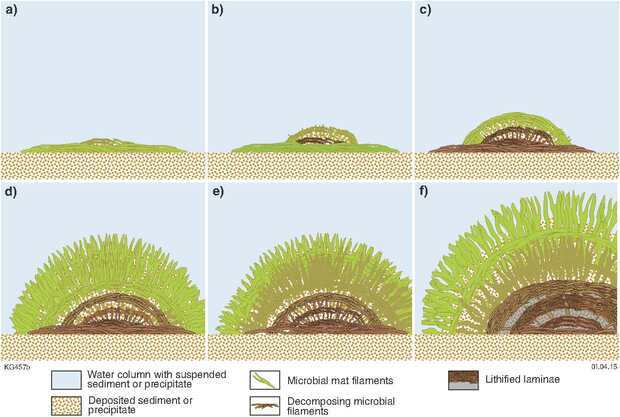Stromatolites: The Earth’s oldest living lifeforms
Stromatolites are living fossils and the oldest living lifeforms on our planet. The name derives from the Greek, stroma, meaning “mattress”, and lithos, meaning “rock”. Stromatolite literally means “layered rock”. The existence of these ancient rocks extends three-quarters of the way back to the origins of the Solar System.
With a citizen scientist’s understanding, stromatolites are stony structures built by colonies of microscopic photosynthesising organisms called cyanobacteria. As sediment layered in shallow water, bacteria grew over it, binding the sedimentary particles and building layer upon millimetre layer until the layers became mounds. Their empire-building brought with it their most important role in Earth’s history. They breathed. Using the sun to harness energy, they produced and built up the oxygen content of the Earth’s atmosphere to about 20%, giving the kiss of life to all that was to evolve.
Living stromatolites are now only found in only a few salty lagoons or bays on Earth. Western Australia is internationally significant for its variety of stromatolite sites, both living and fossilised. Fossils of the earliest known stromatolites, about 3.5 billion years old, are found about 1,000km north, near Marble Bar in the Pilbara region. With Earth an estimated 4.5 billion years old, it’s staggering to realise we can witness how the world looked at the dawn of time when the continents were forming, before plants, before dinosaurs, before humans.
How microbialites form
Microbialites are structures built mainly by photosynthetic cyanobacteria. Cyanobacteria are microscopic organisms found naturally in all types of water. These single-celled organisms live in fresh, brackish (combined salt and fresh water), and marine salty water. These organisms use sunlight to make their own food. These structures are still found today, but were much more common in the geological past, dominating the fossil record in the Proterozoic Eon.

Characteristics of microbialite formation include the following:
- within the mat, microbes will either trap and bind sediments or precipitate minerals forming alternating layers of organic-rich filaments and sediments
- as microbes are photosynthetic, they will slowly move up through deposited layers to reach light, thereby progressively forming new layers on the outer surface. Trapped or precipitated sediments in the older layers within the structure will then harden into rock (lithify)
- over long periods of time, these layers of sediments and microbes build up to form stratiform, domical, columnar, conical, or complex branching structures
- structures formed by microbes can range in size from smaller than a little finger to larger than a house. Some branching stromatolites resemble modern corals
- many microbes are photosynthetic and produce oxygen as a result of their metabolic activities. In the Proterozoic Eon, such organisms converted Earth's atmosphere from one dominated by greenhouse gases to one with breathable oxygen.
To Log this Earth Cache, the following questions must be answered and submitted to the CO:
1. What does Stromatolite mean?
2. What is the name given to the blue-green algae micro organism ?
3. Today, these Stromatolites are found far from salty waters. Why is this the case?
4. Above the granite information plaque at GZ, there is a sample of a Stromatolite found on the property. Describe it's shape.
Don't forget to submit your answers.
Note that the establishment is closed on Mondays.